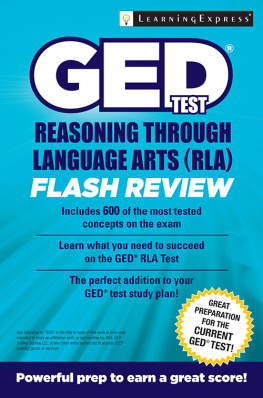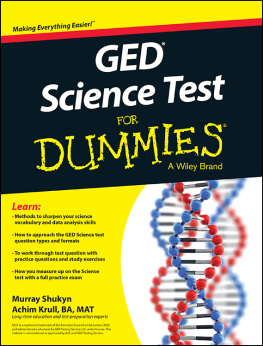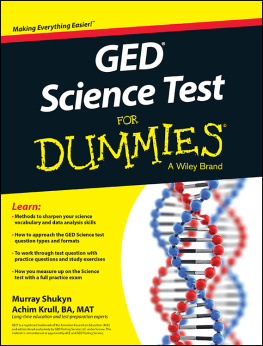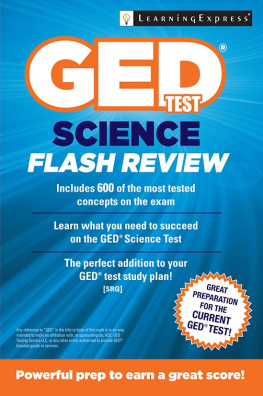LLC LearningExpress - GED Test Science Flash Review
Here you can read online LLC LearningExpress - GED Test Science Flash Review full text of the book (entire story) in english for free. Download pdf and epub, get meaning, cover and reviews about this ebook. year: 2015, publisher: Learningexpress, LLC, genre: Children. Description of the work, (preface) as well as reviews are available. Best literature library LitArk.com created for fans of good reading and offers a wide selection of genres:
Romance novel
Science fiction
Adventure
Detective
Science
History
Home and family
Prose
Art
Politics
Computer
Non-fiction
Religion
Business
Children
Humor
Choose a favorite category and find really read worthwhile books. Enjoy immersion in the world of imagination, feel the emotions of the characters or learn something new for yourself, make an fascinating discovery.
- Book:GED Test Science Flash Review
- Author:
- Publisher:Learningexpress, LLC
- Genre:
- Year:2015
- Rating:3 / 5
- Favourites:Add to favourites
- Your mark:
- 60
- 1
- 2
- 3
- 4
- 5
GED Test Science Flash Review: summary, description and annotation
We offer to read an annotation, description, summary or preface (depends on what the author of the book "GED Test Science Flash Review" wrote himself). If you haven't found the necessary information about the book — write in the comments, we will try to find it.
GED Test Science Flash Review — read online for free the complete book (whole text) full work
Below is the text of the book, divided by pages. System saving the place of the last page read, allows you to conveniently read the book "GED Test Science Flash Review" online for free, without having to search again every time where you left off. Put a bookmark, and you can go to the page where you finished reading at any time.
Font size:
Interval:
Bookmark:
EARTH AND SPACE SCIENCE Select the best answer to fill each blank from the choices that follow. The _______ is a solid mass of iron with a temperature of about 7,000F. The _______ is a mass of molten iron that surrounds the solid inner core. Electrical currents generated from this area produce Earths magnetic field. The _______ is composed of silicon, oxygen, magnesium, iron, aluminum, and calcium and is about 1,750 miles thick. When parts of this layer become hot enough, they turn to slow-moving molten rock or magma.
The _______ is a layer from 4 to 25 miles thick, consisting of sand and rock. outer core crust inner core rocky mantle ................................ Select the best answer to fill each blank from the choices that follow. Sunlight _______ water from the oceans, rivers, and lakes. Living beings need water for both the outside and the inside of their cells. In fact, vertebrates (you included) are about 70% water.
Evaporated water _______ to form clouds that produce rain or snow onto the earths surface (_______). precipitation evaporates condenses ................................ The inner core is a solid mass of iron with a temperature of about 7,000F. The outer core is a mass of molten iron that surrounds the solid inner core. Electrical currents generated from this area produce Earths magnetic field. The rocky mantle is composed of silicon, oxygen, magnesium, iron, aluminum, and calcium and is about 1,750 miles thick.
When parts of this layer become hot enough, they turn to slow-moving molten rock or magma. The crust is a layer from 4 to 25 miles thick, consisting of sand and rock. ................................ Sunlight evaporates water from the oceans, rivers, and lakes. Living beings need water for both the outside and the inside of their cells. In fact, vertebrates (you included) are about 70% water.
Evaporated water condenses to form clouds that produce rain or snow onto the earths surface ( precipitation ). ................................ Describe two ways that trees and other organisms contribute to the carbon cycle. ................................ What results when tectonic plates converge? A. oceans C. trenches D. trenches D.
El Nio ................................ Explain how ocean currents can affect weather globally and locally. Answer briefly. Sample answer (this answer may not match your own exactly). Plants remove carbon dioxide, CO , from the atmosphere and convert it to sugars through photosynthesis. ................................ ................................
Converging plates result in the creation of choice A , mountains . For example, the Andes mountain chain was formed by the Nazca Plate being pushed against the South American Plate. Tectonic plates can slide past each other, separate from each other (diverge), or come together (converge). Oceans, such as the Atlantic, are formed by the separation of plates over millions of years. Trenches are deep channels in the ocean. ................................ ................................
Your answer will vary. Here is an example. The Gulf Stream is an ocean current that runs from the tip of Florida and flows along the eastern United States to Newfoundland before crossing the Atlantic Ocean. Because it carries warm water, it makes Northern Europe warmer than it would be otherwise. The oceans can affect global weather. For example, El Nio is a band of very warm ocean water that develops off the western coast of South America and can cause climatic changes.
Because El Nios warm waters feed thunderstorms, it creates increased rainfall across the eastern Pacific Ocean. Along the west coast of South America, El Nio reduces the upwelling of cold, nutrient-rich water that sustains large fish populations. The reduction in upwelling has led to fish kills off the shore of Peru. The impact of El Nio can be felt across the globe. El Nio is A. B. the phenomenon of the suns rays bouncing off the Earths surface and being trapped in the atmosphere by greenhouse gases. C. very large destructive water waves caused by earthquakes, volcanic eruptions, or landslides (not wind). D. a band of warm ocean temperatures that develops off the west coast of South America. ................................ ................................
What is the role of the ocean in the carbon cycle? A. The ocean absorbs carbon from the atmosphere. B. The ocean produces carbon dioxide. C. D. D.
Water evaporates from the ocean surface. ................................ Earthquakes are caused by A. tsunamis. B. C. plate tectonics. D. ocean currents. ocean currents.
The correct answer is choice D . El Nio develops in some years off the west coast of South America as a warm band of ocean water. The other choices describe the Gulf Stream, the greenhouse effect, and tsunamis. ................................ The ocean absorbs carbon from the atmosphere, choice A . The ocean does not produce carbon dioxide.
The transfer of heat and water evaporating from the ocean surface are not related to the carbon cycle. ................................ Earthquakes are caused by the shifting of choice C , tectonic plates. Tsunamis (tidal waves) can result from earthquakes, but do not cause them. Global warming causes other natural disasters, but not earthquakes. Ocean currents do not cause earthquakes.
Compared to Earths crust, the inner core is A. hotter and contains more molten iron. B. hotter and contains more solid iron. C. D. hotter and contains mostly sand and rock. ................................ ................................
Solar power refers to the conversion of solar energy to another, more useful form. Sunlight can be harnessed and collected in special greenhouses. Photovoltaic cells can produce electricity when sunlight hits them. The amount of energy from the sun that reaches Earth is about 8,000 times the energy humans use. Many scientists are convinced that this form of energy will one day replace ordinary fossil fuels. In 2012, about 0.14% of all electricity generation was from solar power.
This may seem like a small percentage of overall energy production, but it represents a 58% increase over 2011. Why dont we see more of our energy coming from solar power? A. Sunlight is always available. B. Fossil fuels are still cheaper. C.
Fossil fuels will never run out. D. We do not know how to produce solar power. ................................ Choice B is correct. ................................ ................................
Choice B is correctfossil fuels are still cheaper. All the other answers are not accurate. ................................ Match each of the following natural resources with its correct label: renewable or nonrenewable. 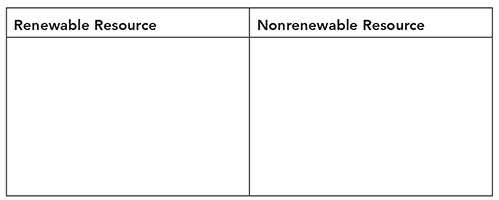
coal sun gas water oil wind plants wood ................................ bounce off Earths surface and are trapped in the atmosphere by greenhouse gases. B. pass through the atmosphere and warm Earths surface. C. bounce off clouds and get absorbed by greenhouse gases. D. move through the atmosphere and are absorbed by oceans. ................................ 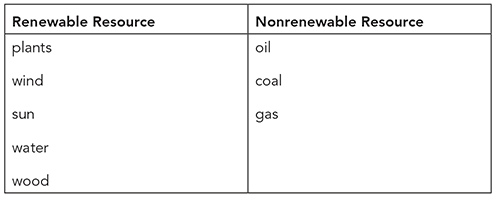
................................ 
................................
The greenhouse effect occurs when the suns rays bounce off Earths surface and are trapped in the atmosphere by greenhouse gases, choice A . Greenhouse gases trap the suns rays in the atmosphere, causing a temperature rise similar to how a greenhouse works. ................................ A ____________ is a system of stars, stellar dust, and dark matter bound together by gravity. The ____________ comprises the sun and all planets and other objects that orbit it (including Earth). ................................
Next pageFont size:
Interval:
Bookmark:
Similar books «GED Test Science Flash Review»
Look at similar books to GED Test Science Flash Review. We have selected literature similar in name and meaning in the hope of providing readers with more options to find new, interesting, not yet read works.
Discussion, reviews of the book GED Test Science Flash Review and just readers' own opinions. Leave your comments, write what you think about the work, its meaning or the main characters. Specify what exactly you liked and what you didn't like, and why you think so.


